The School Lunch Program and the Federal Government
Making Connections
All documents and text associated with this activity are printed below, followed by a worksheet for student responses.Introduction
School Lunch is an important part of the school day! Close your eyes and think about lunch in your school.What do you hear and smell? What is the typical price of a school lunch? Why are the prices of food and drink lower at the school cafeteria than in a restaurant? Does the federal government play a role in your local school lunch program?
To find the answers, analyze the documents in the activity and respond to the questions in the text boxes.
Name:
Class:
Class:
Worksheet
The School Lunch Program and the Federal Government
Making Connections
Examine the documents and text included in this activity. Fill in any blanks in the sequence with your thoughts and write your conclusion response in the space provided.Analyze the first three photographs. How are they connected? How can increased food production contribute to farm foreclosures? What event in United States History does the event in the third photograph reflect? Why is it ironic that farmers were able to grow more food, but there were farm foreclosures and people in cities who were starving?
Hybrid Corn Crossing Plot
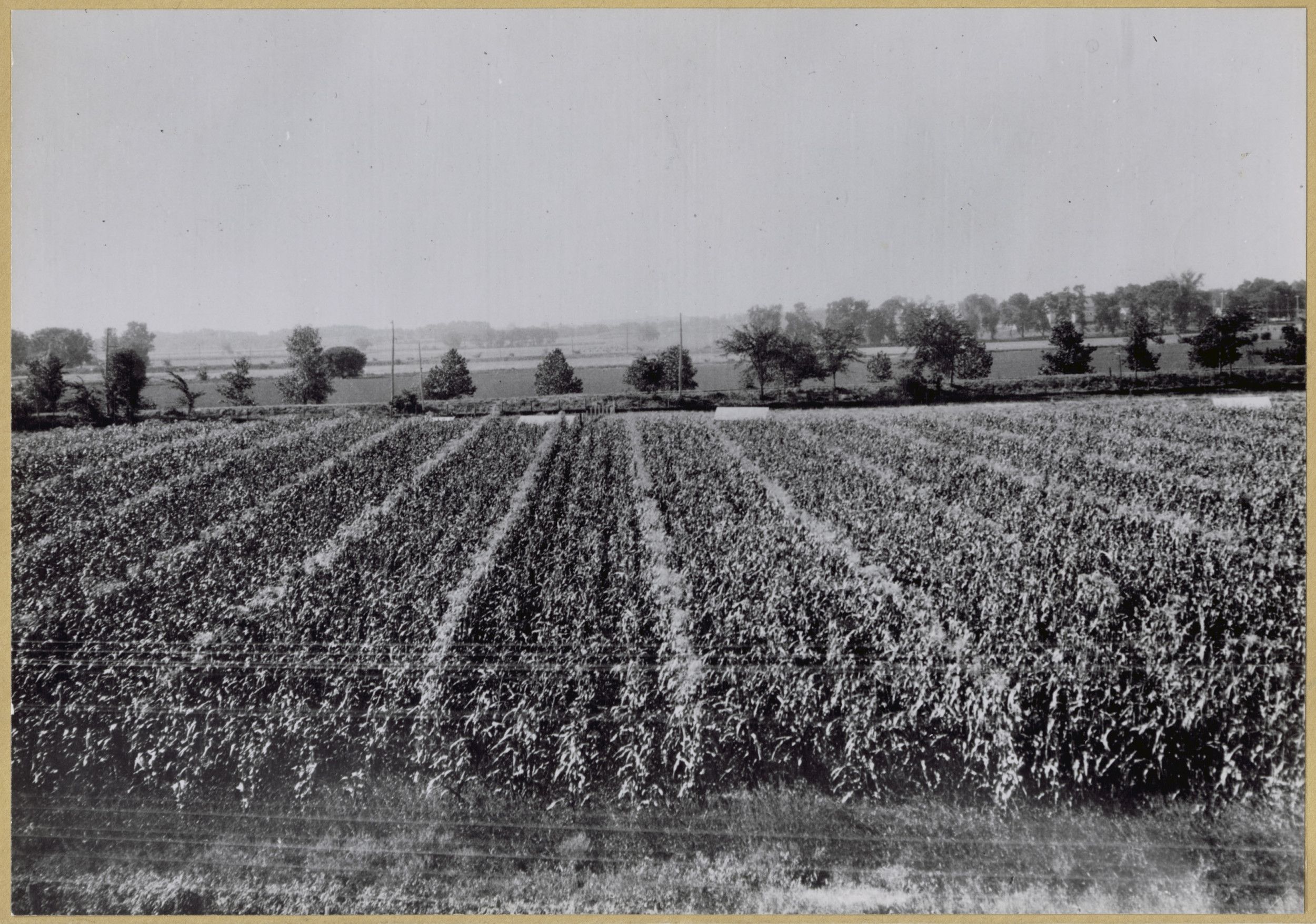
Farm foreclosure sale in Iowa

Depression: Breadlines:long line of people waiting to be fed: New York City: in the absence of substantial government relief programs during 1932, free food was distributed with private funds in some
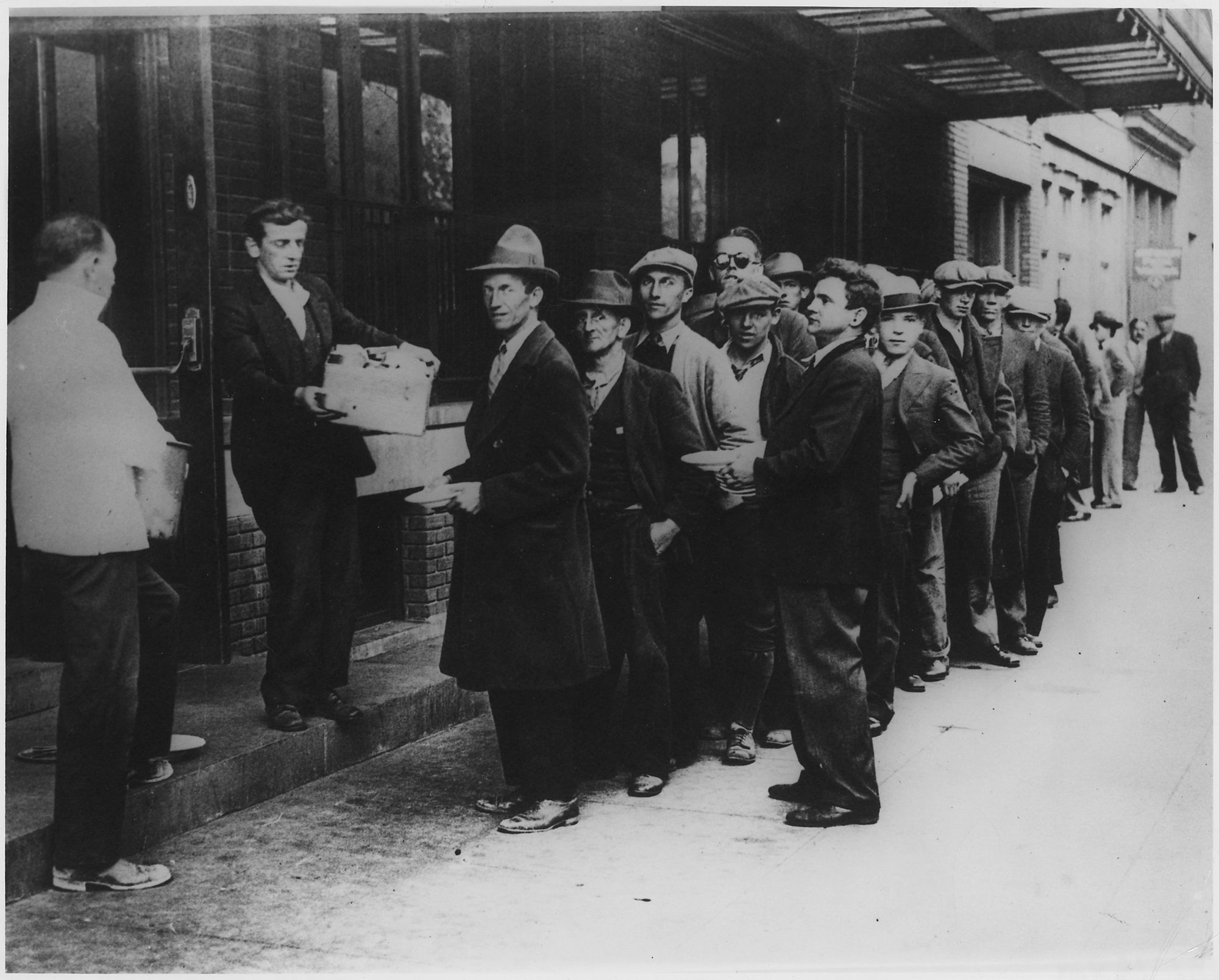
Franklin Delano Roosevelt was elected president in the midst of the Great Depression. He realized changes had to happen immediately to assist the American people.
Analyze the next three documents. Read carefully pages 5 and 6 of F.D.R.'s Fireside Chat on the purposes and foundations for the National Recovery Act, looking specifically at the information related to farmers in the United States. Analyze the the two photographs in the group.
Based on your findings, what are possible solutions to the overproduction of crops?
Analyze the next three documents. Read carefully pages 5 and 6 of F.D.R.'s Fireside Chat on the purposes and foundations for the National Recovery Act, looking specifically at the information related to farmers in the United States. Analyze the the two photographs in the group.
Based on your findings, what are possible solutions to the overproduction of crops?
Fireside Chat on the Purposes and Foundations of the Recovery Program
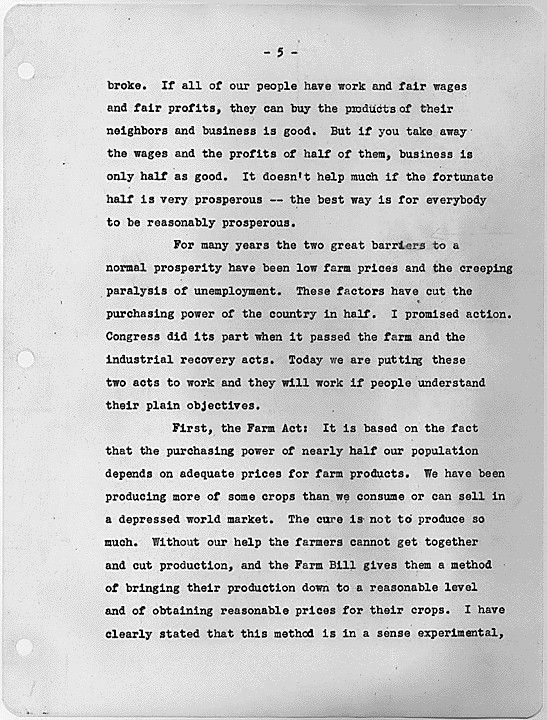
Shelby County, Iowa. Corn sealed in farm granaries under the Ever-Normal granary plan

Surplus Commodities Program
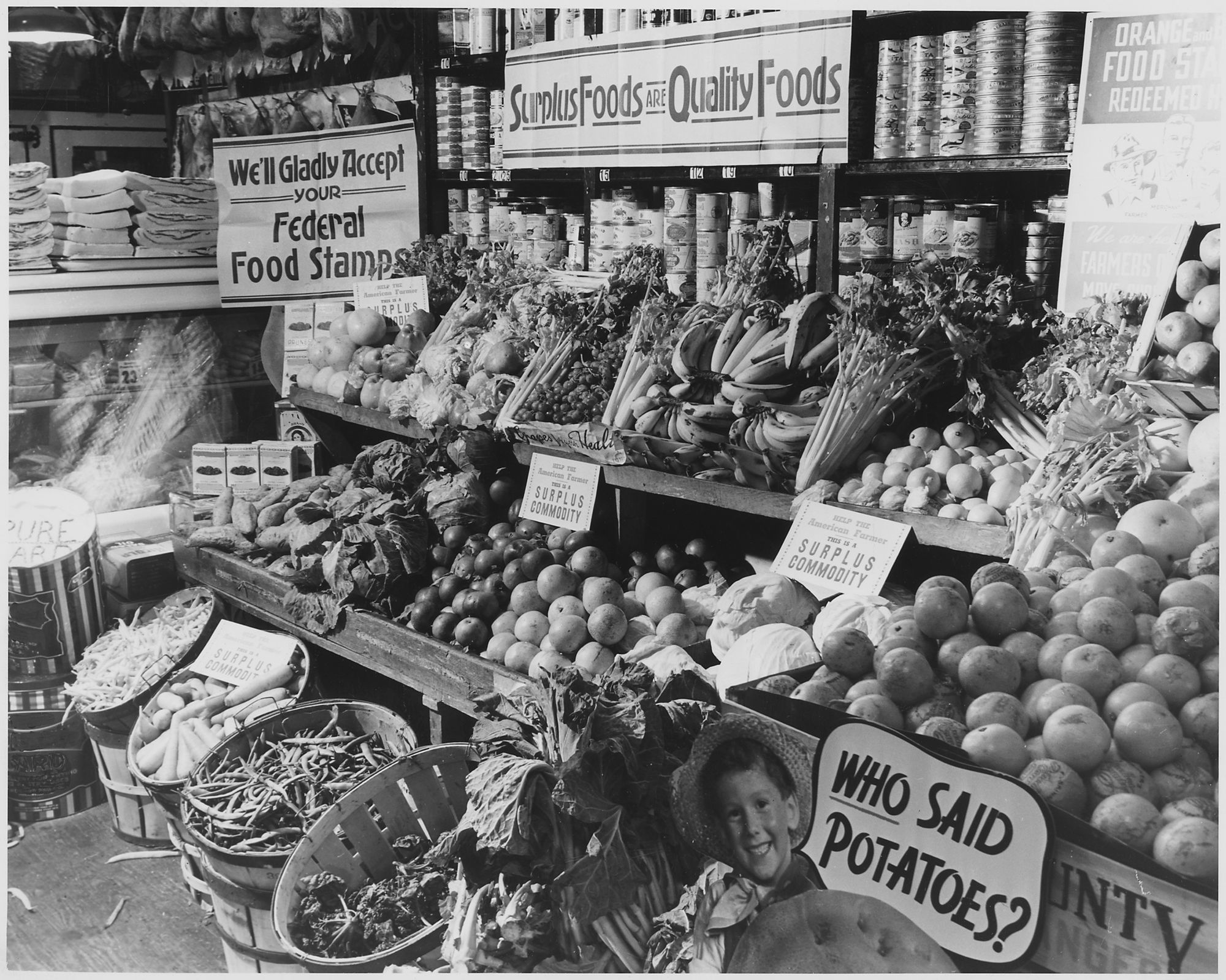
Examine the next three documents. Who were the recipients of surplus agricultural products?
"Your community can sponsor a school lunch program for its children" Make America Strong set. Poster number 10.

"Every child Needs a Good School Lunch"
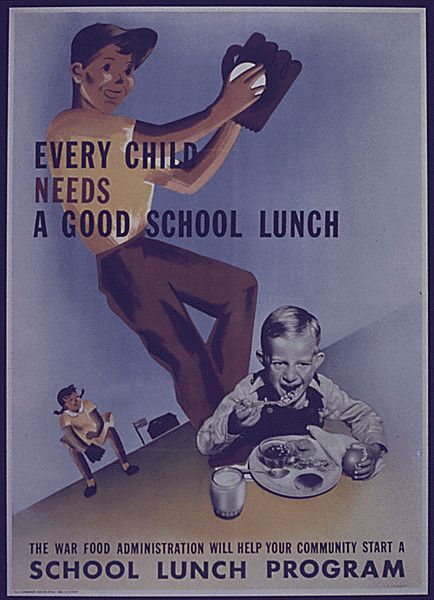
Surplus Commodities: School Lunch Program

The Federal Surplus Commodities Corporation purchased surplus commoditieis such as pork, dairy products, and wheat and made them available to schoolchildren who could not afford to pay for lunches and needed nutritional food. By 1942, the peak year, more than 5 million children participated in the school lunch program. The legislation for the school lunch program was not permanent.
Analyze the next two documents.
What happened to the School Lunch program?
Analyze the next two documents.
What happened to the School Lunch program?
Letter from Mrs. Morton Livingston to Senator Claude Pepper Regarding the School Lunch Program
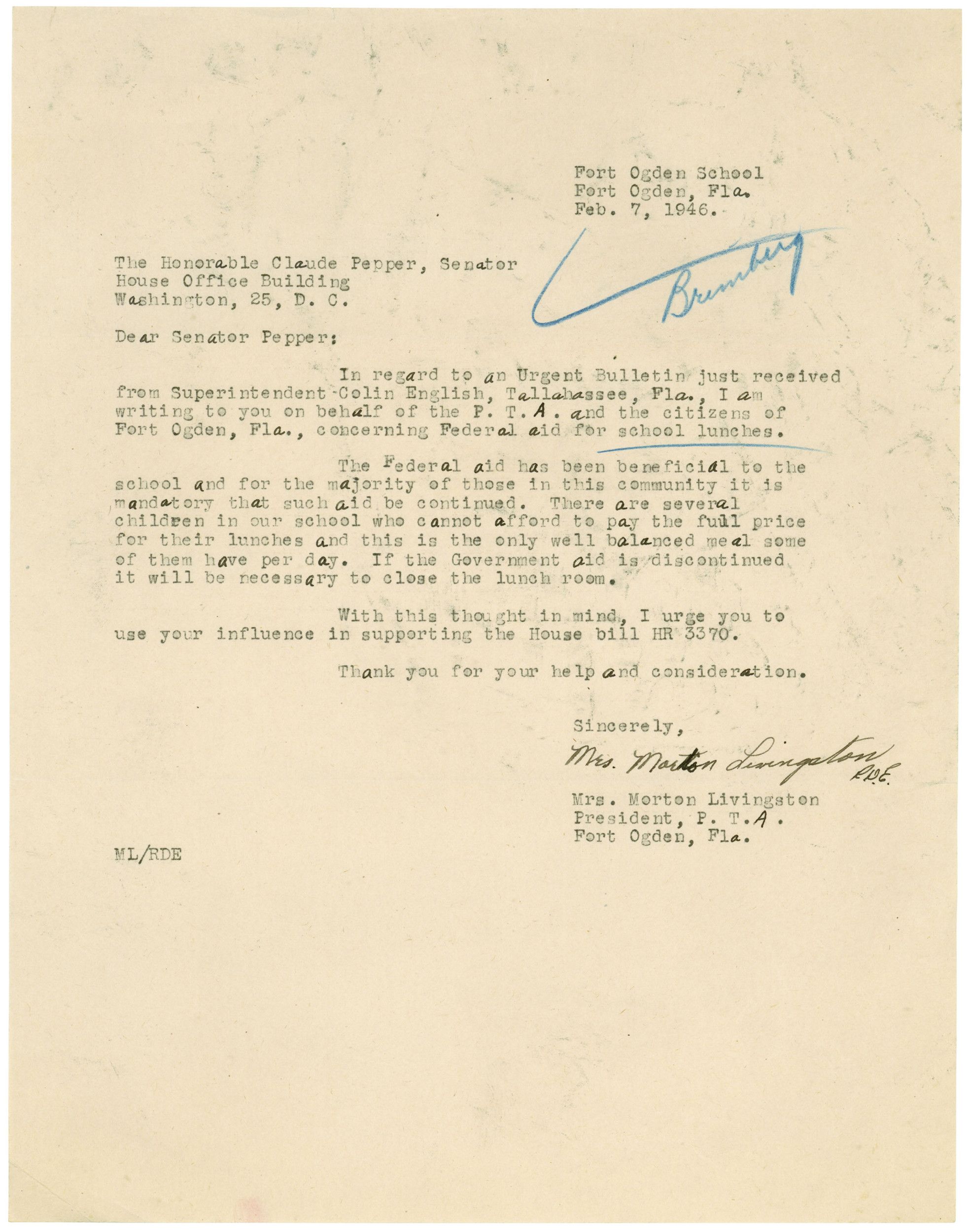
School Lunch Recipes for 100
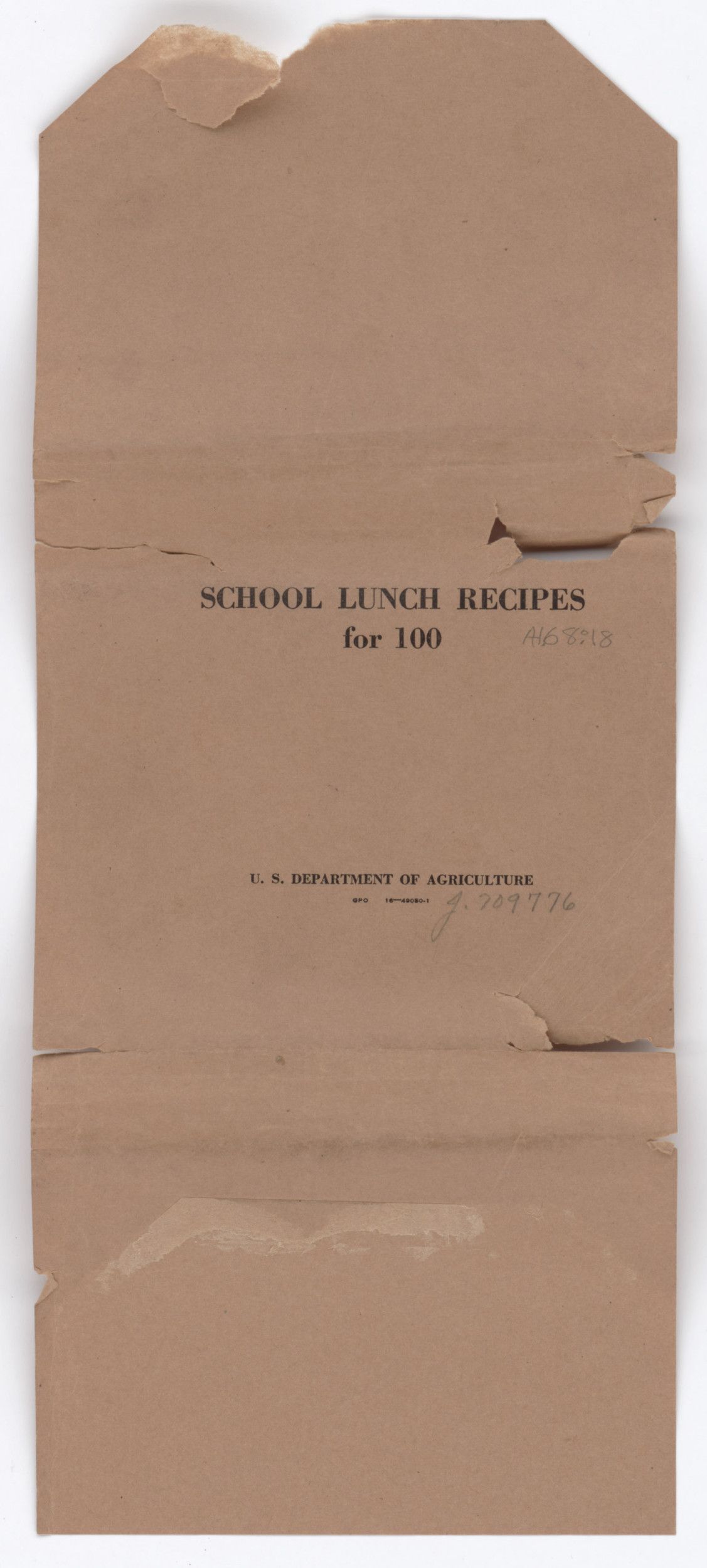
Examine the last two documents.
Does the school lunch program still exist?
How has it changed? How has it stayed the same?
How did increased agricultural production and the Great Depression contribute to the School Lunch program?
Does the school lunch program still exist?
How has it changed? How has it stayed the same?
How did increased agricultural production and the Great Depression contribute to the School Lunch program?
Senate Democrats Dine on School Lunch

Quantity Recipes for School Food Service

1
Activity Element
Hybrid Corn Crossing Plot
Page 1

2
Activity Element
Farm foreclosure sale in Iowa
Page 1

3
Activity Element
Depression: Breadlines:long line of people waiting to be fed: New York City: in the absence of substantial government relief programs during 1932, free food was distributed with private funds in some
Page 1

4
Activity Element
Fireside Chat on the Purposes and Foundations of the Recovery Program
Page 5

5
Activity Element
Shelby County, Iowa. Corn sealed in farm granaries under the Ever-Normal granary plan
Page 1

6
Activity Element
Surplus Commodities Program
Page 1

7
Activity Element
"Your community can sponsor a school lunch program for its children" Make America Strong set. Poster number 10.
Page 1

8
Activity Element
"Every child Needs a Good School Lunch"
Page 1

9
Activity Element
Surplus Commodities: School Lunch Program
Page 1

10
Activity Element
Letter from Mrs. Morton Livingston to Senator Claude Pepper Regarding the School Lunch Program
Page 1

11
Activity Element
School Lunch Recipes for 100
Page 1

12
Activity Element
Senate Democrats Dine on School Lunch
Page 1

13
Activity Element
Quantity Recipes for School Food Service
Page 1

Conclusion
The School Lunch Program and the Federal Government
Making Connections
In the response section below, explain the following questions.- How and why the federal school lunch program started?
- When did the school lunch program become a permanent part of federal programs?
Surplus agricultural commodities are the mainstay of the school lunch program. These commodities often include dairy products, pork, and wheat--products that tend to be high in both calories and fat content.
- Why is that a problem in the diet of many students today?
- What legislation was passed by Congress in 2010 to address this issue?
Your Response
Document
Hybrid Corn Crossing Plot
ca. 1932
Hybrid corn, considered by many to be one of the most important discoveries in the history of farming, was cultivated and tested at experiment stations like this one in Iowa, ca.1932. The dense green rows of identical stalks of corn in demonstration fields won over many a dubious farmer.
This primary source comes from the Records of the Office of the Secretary of Agriculture.
National Archives Identifier: 5709998
Full Citation: Hybrid Corn Crossing Plot; ca. 1932; Records of the Office of the Secretary of Agriculture, . [Online Version, https://docsteach.org/documents/document/hybrid-corn-crossing-plot, April 20, 2024]Hybrid Corn Crossing Plot
Page 1

Document
Farm foreclosure sale in Iowa
ca. 1933
This primary source comes from the Collection FDR-PHOCO: Franklin D. Roosevelt Library Public Domain Photographs.
National Archives Identifier: 196314
Full Citation: Farm foreclosure sale in Iowa; ca. 1933; Collection FDR-PHOCO: Franklin D. Roosevelt Library Public Domain Photographs, . [Online Version, https://docsteach.org/documents/document/farm-foreclosure-sale-in-iowa, April 20, 2024]Farm foreclosure sale in Iowa
Page 1
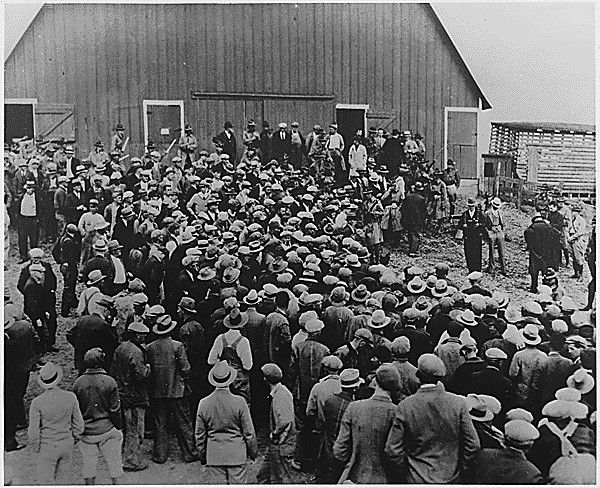
Document
Depression: Breadlines: Long line of people waiting to be fed: New York City
ca. 2/1932
The original caption for this photograph reads: "Depression: Breadlines: Long line of people waiting to be fed: New York City: In the absence of substantial government relief programs during 1932, free food was distributed with private funds in some urban centers to large numbers of the unemployed."
This primary source comes from the Collection FDR-PHOCO: Franklin D. Roosevelt Library Public Domain Photographs.
National Archives Identifier: 196506
Full Citation: Photograph PHOCO-A-69146; Depression: Breadlines: Long line of people waiting to be fed: New York City; ca. 2/1932; Franklin D. Roosevelt Library Public Domain Photographs, 1882 - 1962; Collection FDR-PHOCO: Franklin D. Roosevelt Library Public Domain Photographs, ; Franklin D. Roosevelt Library, Hyde Park, NY. [Online Version, https://docsteach.org/documents/document/breadline, April 20, 2024]Depression: Breadlines: Long line of people waiting to be fed: New York City
Page 1
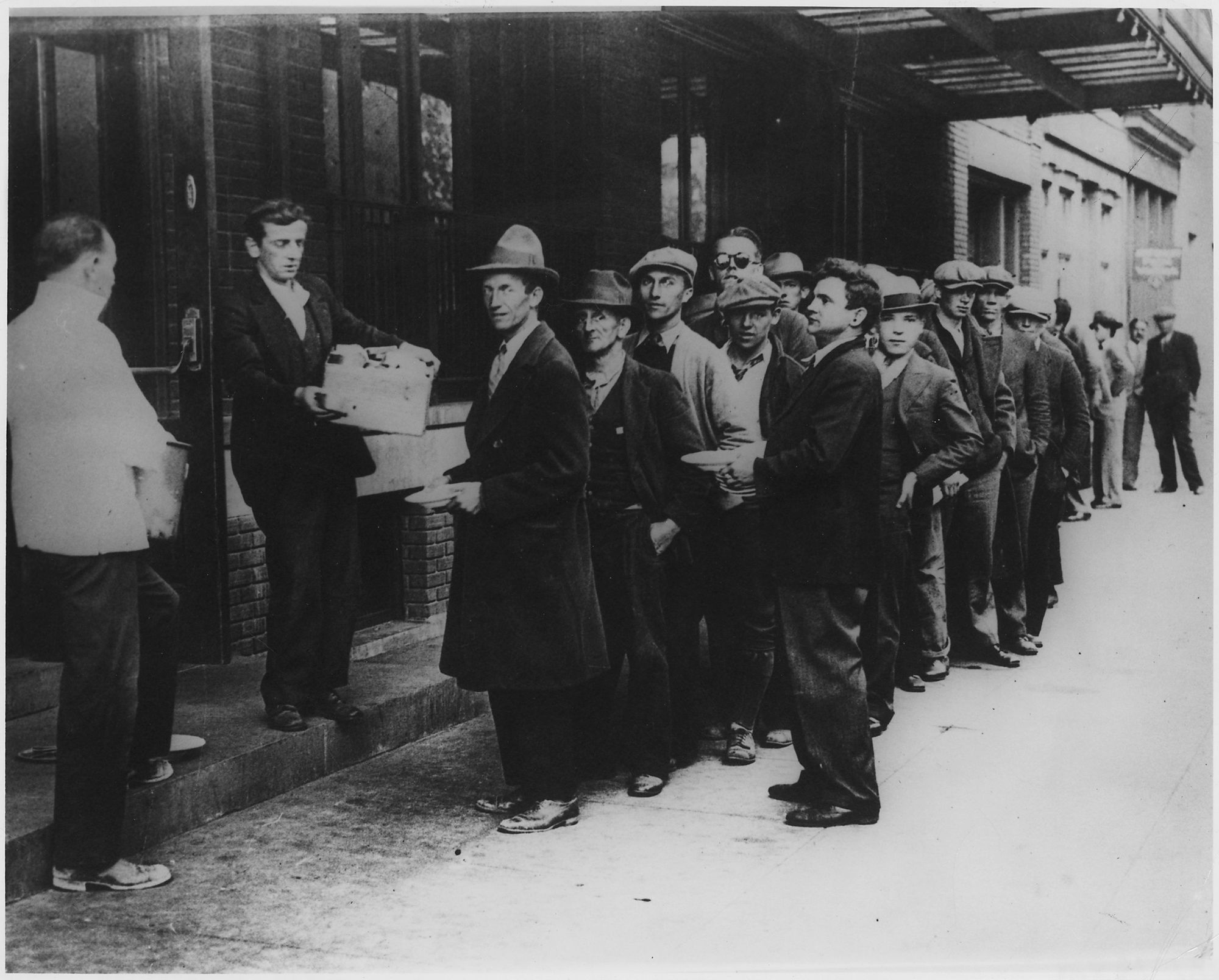
Document
Fireside Chat on the Purposes and Foundations of the Recovery Program
7/24/1933
In this radio message, President Franklin D. Roosevelt discussed the National Recovery Administration (NRA) and addressed some of the problems and issues of the Great Depression. This fireside chat also focused on what industry, employers, and workers could do to bring about economic recovery.
Congress had passed the National Industrial Recovery Act (NIRA) in June to address the problems of industry and workers during the Great Depression. The NIRA established codes of fair practice for individual industries in order to promote industrial growth. It also created the NRA. The NRA was perhaps one of the most sweeping and controversial of the early New Deal programs. Its purposes were twofold: first, to stabilize business with codes of "fair" competitive practice and, second, to generate more purchasing power by providing jobs, defining labor standards, and raising wages. The NRA also reflected trade union hopes for protection of basic hour and wage standards.
For a time, the NRA worked. It gave an air of confidence to the American people to overcome the fears of the Depression and the downward turn of wages and prices. However, once recovery began, hostility among businessmen grew with the daily annoyances of code enforcement. Within two years the NRA had developed many critics and by May 1935 was struck down by the Supreme Court as unconstitutional. Regardless, the codes established by the NRA set new standards for business and workers, such as the 40-hour week and the end of child labor. The NRA also helped the growth of unions with the endorsement of collective bargaining.
Congress had passed the National Industrial Recovery Act (NIRA) in June to address the problems of industry and workers during the Great Depression. The NIRA established codes of fair practice for individual industries in order to promote industrial growth. It also created the NRA. The NRA was perhaps one of the most sweeping and controversial of the early New Deal programs. Its purposes were twofold: first, to stabilize business with codes of "fair" competitive practice and, second, to generate more purchasing power by providing jobs, defining labor standards, and raising wages. The NRA also reflected trade union hopes for protection of basic hour and wage standards.
For a time, the NRA worked. It gave an air of confidence to the American people to overcome the fears of the Depression and the downward turn of wages and prices. However, once recovery began, hostility among businessmen grew with the daily annoyances of code enforcement. Within two years the NRA had developed many critics and by May 1935 was struck down by the Supreme Court as unconstitutional. Regardless, the codes established by the NRA set new standards for business and workers, such as the 40-hour week and the end of child labor. The NRA also helped the growth of unions with the endorsement of collective bargaining.
Transcript
After the adjournment of the historical special session of the Congress five weeks ago I purposely refrained from addressing you for two very good reasons.First, I think that we all wanted the opportunity of a little quiet thought to examine and assimilate in a mental picture the crowding events of the hundred days which had been devoted to the starting of the wheels of the New Deal.
Secondly, I wanted a few weeks in which to set up the new administrative organization and to see the first fruits of our careful planning.
I think it will interest you if I set forth the fundamentals of this planning for national recovery; and this I am very certain will make it abundantly clear to you that all of the proposals and all of the legislation since the fourth day of March have not been just a collection of haphazard schemes but rather the orderly component parts of a connected and logical whole.
Long before Inauguration Day I became convinced that individual effort and local effort and even disjointed Federal effort had failed and of necessity would fail and, therefore, that a rounded leadership by the Federal Government had become a necessity both of theory and of fact. Such leadership, however, had its beginning in preserving and strengthening the credit of the United States Government, because without that no leadership was a possibility. For years the Government had not lived within its income. The immediate task was to bring our regular expenses within our revenues. That has been done.
It may seem inconsistent for a government to cut down its regular expenses and at the same time to borrow and to spend billions for an emergency. But it is not inconsistent because a large portion of the emergency money has been paid out in the form of sound loans which will be repaid to the Treasury over a period of years; and to cover the rest of the emergency money we have imposed taxes to pay the interest and the installments on that part of the debt.
So you will see that we have kept our credit good. We have built a granite foundation in a period of confusion. That foundation of the Federal credit stands there broad and sure. It is the base of the whole recovery plan.
Then came the part of the problem that concerned the credit of the individual citizens themselves. You and I know of the banking crisis and of the great danger to the savings of our people. On March sixth every national bank was closed. One month later 90 per cent of the deposits in the national banks had been made available to the depositors. Today only about 5 per cent of the deposits in national banks are still tied up. The condition relating to state banks, while not quite so good on a percentage basis, is shoving a steady reduction in the total of frozen deposits -- a result much better than we had expected three months ago.
The problem of the credit of the individual was made more difficult because of another fact. The dollar was a different dollar from the one with which the average debt had been incurred. For this reason large numbers of people were actually losing possession of and title to their farms and homes. All of you know the financial steps which have been taken to correct this inequality. In addition the Home Loan Act, the Farm Loan Act and the Bankruptcy Act were passed.
It was a vital necessity to restore purchasing power by reducing the debt and interest charges upon our people, but while we were helping people to save their credit it was at the same time absolutely essential to do something about the physical needs of hundreds of thousands who were in dire straits at that very moment. Municipal and State aid were being stretched to the limit. We appropriated half a billion dollars to supplement their efforts and in addition, as you know, we have put 300,000 young men into practical and useful work in our forests and to prevent flood and soil erosion. The wages they earn are going in greater part to the support of the nearly one million people who constitute their families.
In this same classification we can properly place the great public works program running to a total of over Three Billion Dollars -- to be used for highways and ships and flood prevention and inland navigation and thousands of self-sustaining state and municipal improvements. Two points should be made clear in the allotting and administration of these projects -- first, we are using the utmost care to choose labor creating quick-acting, useful projects, avoiding the smell of the pork barrel; and secondly, we are hoping that at least half of the money will come back to the government from projects which will pay for themselves over a period of years.
Thus far I have spoken primarily of the foundation stones -- the measures that were necessary to re-establish credit and to head people in the opposite direction by preventing distress and providing as much work as possible through governmental agencies. Now I come to the links which will build us a more lasting prosperity. I have said that we cannot attain that in a nation half boom and half broke. If all of our people have work and fair wages and fair profits, they can buy the products of their neighbors and business is good. But if you take away the wages and the profits of half of them, business is only half as good. It doesn't help much if the fortunate half is very prosperous -- the best way is for everybody to be reasonably prosperous.
For many years the two great barriers to a normal prosperity have been low farm prices and the creeping paralysis of unemployment. These factors have cut the purchasing power of the country in half. I promised action. Congress did its part when it passed the farm and the industrial recovery acts. Today we are putting these two acts to work and they will work if people understand their plain objectives.
First, the Farm Act: It is based on the fact that the purchasing power of nearly half our population depends on adequate prices for farm products. We have been producing more of some crops than we consume or can sell in a depressed world market. The cure is not to produce so much. Without our help the farmers cannot get together and cut production, and the Farm Bill gives them a method of bringing their production down to a reasonable level and of obtaining reasonable prices for their crops. I have clearly stated that this method is in a sense experimental, but so far as we have gone we have reason to believe that it will produce good results.
It is obvious that if we can greatly increase the purchasing power of the tens of millions of our people who make a living from farming and the distribution of farm crops, we will greatly increase the consumption of those goods which are turned out by industry.
That brings me to the final step -- bringing back industry along sound lines.
Last Autumn, on several occasions, I expressed my faith that we can make possible by democratic self-discipline in industry general increases in wages and shortening of hours sufficient to enable industry to pay its own workers enough to let those workers buy and use the things that their labor produces. This can be done only if we permit and encourage cooperative action in industry because it is obvious that without united action a few selfish men in each competitive group will pay starvation wages and insist on long hours of work. Others in that group must either follow suit or close up shop. We have seen the result of action of that kind in the continuing descent into the economic Hell of the past four years.
There is a clear way to reverse that process: If all employers in each competitive group agree to pay their workers the same wages -- reasonable wages -- and require the same hours -- reasonable hours -- then higher wages and shorter hours will hurt no employer. Moreover, such action is better for the employer than unemployment and low wages, because it makes more buyers for his product. That is the simple idea which is the very heart of the Industrial Recovery Act.
On the basis of this simple principle of everybody doing things together, we are starting out on this nationwide attack on unemployment. It will succeed if our people understand it -- in the big industries, in the little shops, in the great cities and in the small villages. There is nothing complicated about it and there is nothing particularly new in the principle. It goes back to the basic idea of society and of the nation itself that people acting in a group can accomplish things which no individual acting alone could even hope to bring about.
Here is an example. In the Cotton Textile Code and in other agreements already signed, child labor has been abolished. That makes me personally happier than any other one thing with which I have been connected since I came to Washington. In the textile industry -- an industry which came to me spontaneously and with a splendid cooperation as soon as the recovery act was signed, -- child labor was an old evil. But no employer acting alone was able to wipe it out. If one employer tried it, or if one state tried it, the costs of operation rose so high that it was impossible to compete with the employers or states which had failed to act. The moment the Recovery Act was passed, this monstrous thing which neither opinion nor law could reach through years of effort went out in a flash. As a British editorial put it, we did more under a Code in one day than they in England had been able to do under the common law in eighty-five years of effort. I use this incident, my friends, not to boast of what has already been done but to point the way to you for even greater cooperative efforts this Summer and Autumn.
We are not going through another Winter like the last. I doubt if ever any people so bravely and cheerfully endured a season half so bitter. We cannot ask America to continue to face such needless hardships. It is time for courageous action, and the Recovery Bill gives us the means to conquer unemployment with exactly the same weapon that we have used to strike down Child Labor.
The proposition is simply this:
If all employers will act together to shorten hours and raise wages we can put people back to work. No employer will suffer, because the relative level of competitive cost will advance by the same amount for all. But if any considerable group should lag or shirk, this great opportunity will pass us by and we will go into another desperate Winter. This must not happen.
We have sent out to all employers an agreement which is the result of weeks of consultation. This agreement checks against the voluntary codes of nearly all the large industries which have already been submitted. This blanket agreement carries the unanimous approval of the three boards which I have appointed to advise in this, boards representing the great leaders in labor, in industry and in social service. The agreement has already brought a flood of approval from every State, and from so wide a cross-section of the common calling of industry that I know it is fair for all. It is a plan --deliberate, reasonable and just -- intended to put into effect at once the most important of the broad principles which are being established, industry by industry, through codes. Naturally, it takes a good deal of organizing and a great many hearings and many months, to get these codes perfected and signed, and we cannot wait for all of them to go through. The blanket agreements, however, which I am sending to every employer will start the wheels turning now, and not six months from now.
There are, of course, men, a few of them who might thwart this great common purpose by seeking selfish advantage. There are adequate penalties in the law, but I am now asking the cooperation that comes from opinion and from conscience. These are the only instruments we shall use in this great summer offensive against unemployment. But we shall use them to the limit to protect the willing from the laggard and to make the plan succeed.
In war, in the gloom of night attack, soldiers wear a bright badge on their shoulders to be sure that comrades do not fire on comrades. On that principle, those who cooperate in this program must know each other at a glance. That is why we have provided a badge of honor for this purpose, a simple design with a legend. "We do our part," and I ask that all those who join with me shall display that badge prominently. It is essential to our purpose.
Already all the great, basic industries have come forward willingly with proposed codes, and in these codes they accept the principles leading to mass reemployment. But, important as is this heartening demonstration, the richest field for results is among the small employers, those whose contribution will give new work for from one to ten people. These smaller employers are indeed a vital part of the backbone of the country, and the success of our plans lies largely in their hands.
Already the telegrams and letters are pouring into the White House --messages from employers who ask that their names be placed on this special Roll of Honor. They represent great corporations and companies, and partnerships and individuals. I ask that even before the dates set in the agreements which we have sent out, the employers of the country who have not already done so -- the big fellows and the little fellows -- shall at once write or telegraph to me personally at the White House, expressing their intention of going through with the plan. And it is my purpose to keep posted in the post office of every town, a Roll of Honor of all those who join with me.
I want to take this occasion to say to the twenty-four governors who are now in conference in San Francisco, that nothing thus far has helped in strengthening this great movement more than their resolutions adopted at the very outset of their meeting, giving this plan their instant and unanimous approval, and pledging to support it in their states.
To the men and women whose lives have been darkened by the fact or the fear of unemployment, I am justified in saying a word of encouragement because the codes and the agreements already approved, or about to be passed upon, prove that the plan does raise wages, and that it does put people back to work. You can look on every employer who adopts the plan as one who is doing his part, and those employers deserve well of everyone who works for a living. It will be clear to you, as it is to me, that while the shirking employer may undersell his competitor, the saving he thus makes is made at the expense of his country's welfare.
While we are making this great common effort there should be no discord and dispute. This is no time to cavil or to question the standard set by this universal agreement. It is time for patience and understanding and cooperation. The workers of this country have rights under this law which cannot be taken from them, and nobody will be permitted to whittle them away, but, on the other hand, no aggression is now necessary to attain those rights. The whole country will be united to get them for you. The principle that applies to the employers applies to the workers as well, and I ask you workers to cooperate in the same spirit.
When Andrew Jackson, "Old Hickory," died, someone asked, "Will he go to Heaven?" and the answer was, "He will if he wants to." If I am asked whether the American people will pull themselves out of this depression, I answer, " They will if they want to." The essence of the plan is a universal limitation of hours of work per week for any individual by common consent, and a universal payment of wages above a minimum, also by common consent. I cannot guarantee the success of this nationwide plan, but the people of this country can guarantee its success. I have no faith in " cure-alls" but I believe that we can greatly influence economic forces. I have no sympathy with the professional economists who insist that things must run their course and that human agencies can have no influence on economic ills. One reason is that I happen to know that professional economists have changed their definition of economic laws every five or ten years for a very long time, but I do have faith, and retain faith, in the strength of common purpose, and in the strength of unified action taken by the American people.
That is why I am describing to you the simple purposes and the solid foundations upon which our program of recovery is built. That is why I am asking the employers of the Nation to sign this common covenant with me -- to sign it in the name of patriotism and humanity. That is why I am asking the workers to go along with us in a spirit of understanding and of helpfulness.
This primary source comes from the Collection FDR-PPF: Papers as President, President's Personal File.
National Archives Identifier: 197304
Full Citation: Fireside Chat on the Purposes and Foundations of the Recovery Program; 7/24/1933; First Carbon Files; Speeches of President Franklin D. Roosevelt, 1933 - 1945; Collection FDR-PPF: Papers as President, President's Personal File, ; Franklin D. Roosevelt Library, Hyde Park, NY. [Online Version, https://docsteach.org/documents/document/fireside-chat-recovery-program, April 20, 2024]Fireside Chat on the Purposes and Foundations of the Recovery Program
Page 1
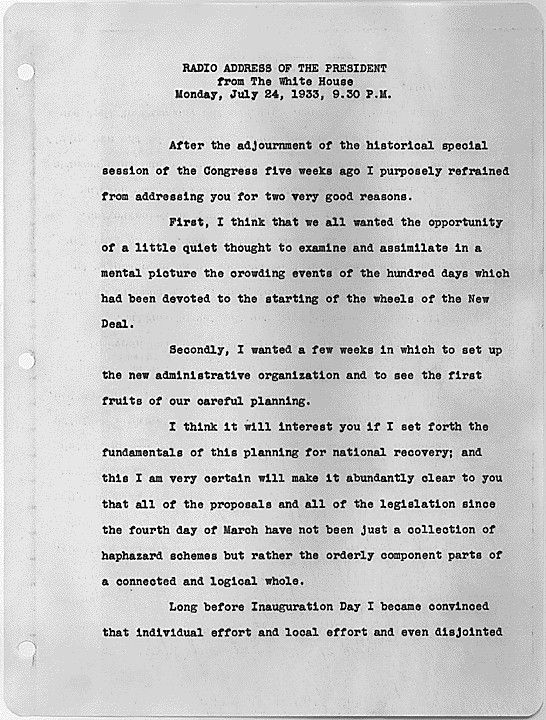
Fireside Chat on the Purposes and Foundations of the Recovery Program
Page 2
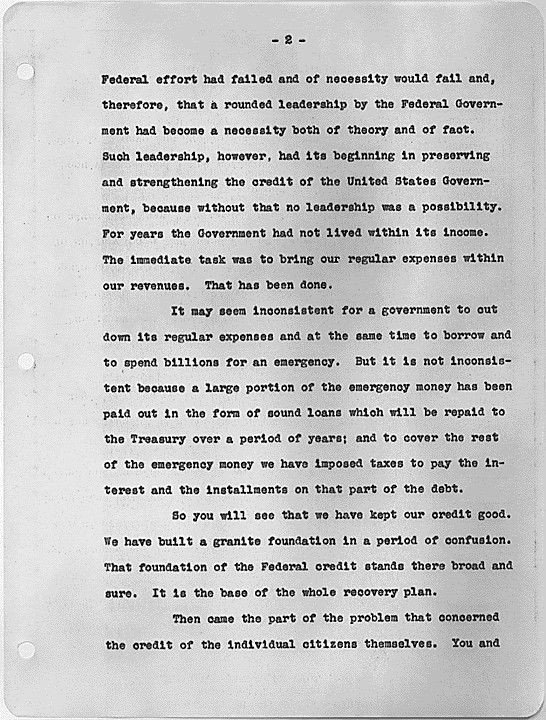
Fireside Chat on the Purposes and Foundations of the Recovery Program
Page 3

Fireside Chat on the Purposes and Foundations of the Recovery Program
Page 4
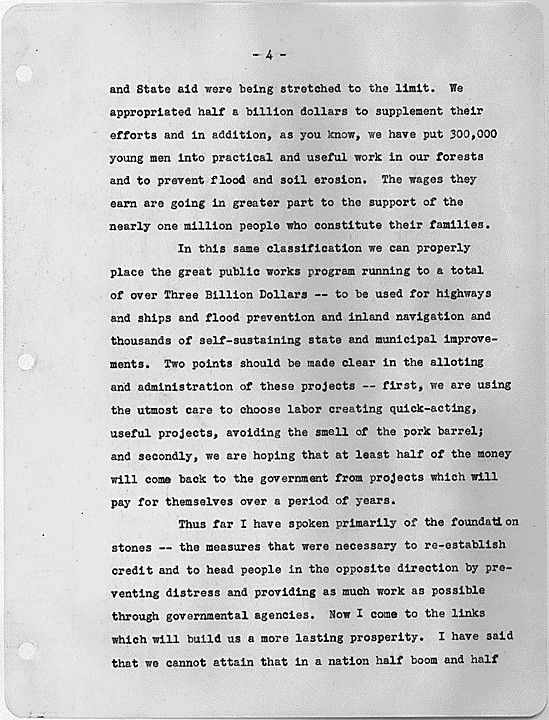
Fireside Chat on the Purposes and Foundations of the Recovery Program
Page 5
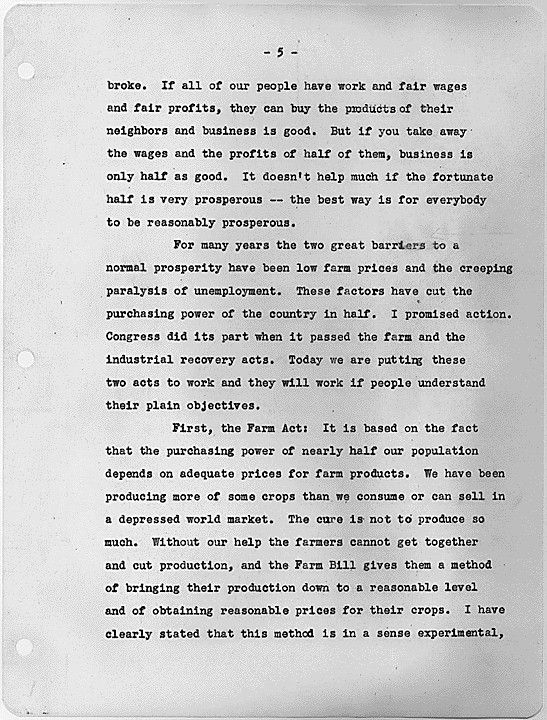
Fireside Chat on the Purposes and Foundations of the Recovery Program
Page 6
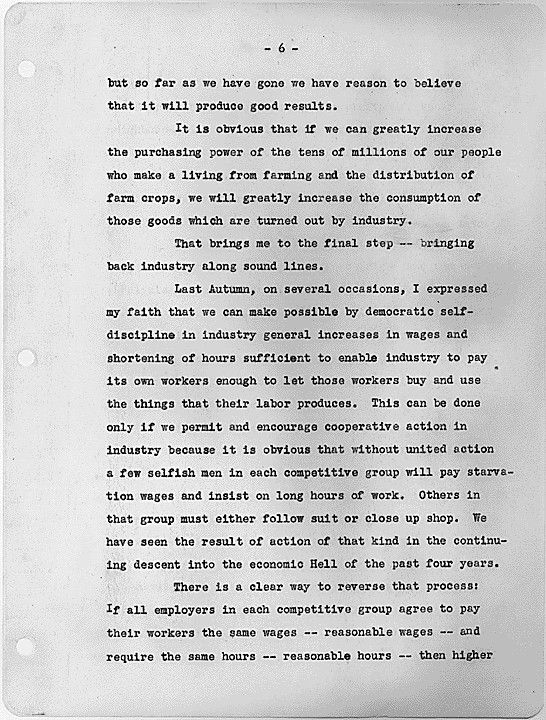
Fireside Chat on the Purposes and Foundations of the Recovery Program
Page 7
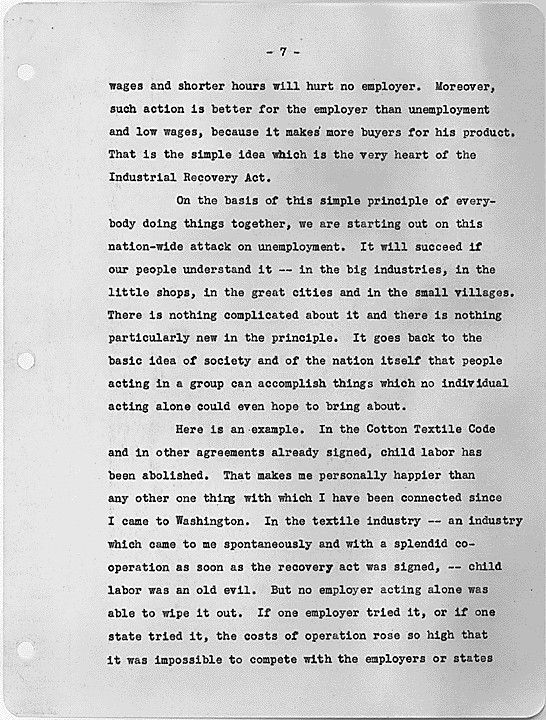
Fireside Chat on the Purposes and Foundations of the Recovery Program
Page 8

Fireside Chat on the Purposes and Foundations of the Recovery Program
Page 9
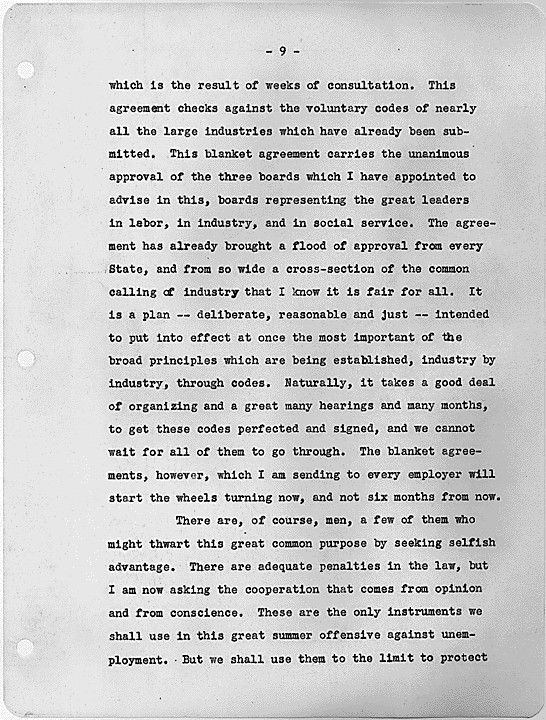
Fireside Chat on the Purposes and Foundations of the Recovery Program
Page 10

Fireside Chat on the Purposes and Foundations of the Recovery Program
Page 11

Fireside Chat on the Purposes and Foundations of the Recovery Program
Page 12

Fireside Chat on the Purposes and Foundations of the Recovery Program
Page 13
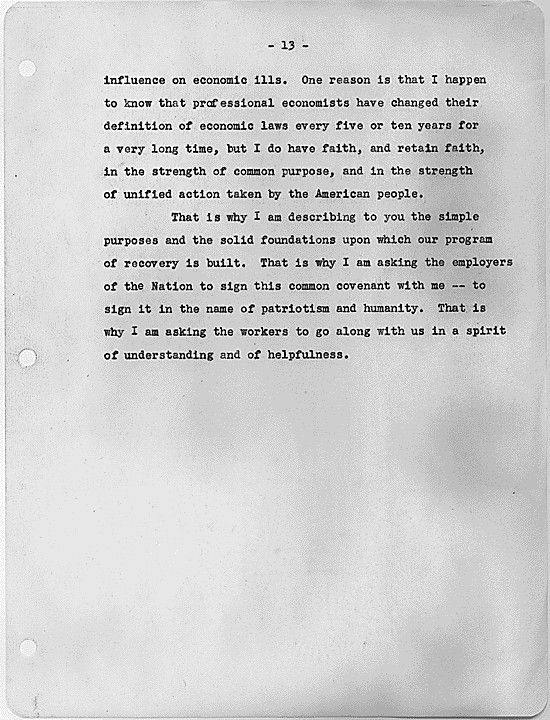
Document
Shelby County, Iowa. Corn sealed in farm granaries under the Ever-Normal granary plan
5/2/1941 - 5/7/1941
The practice of storing surplus grain to keep prices stable or “ever-normal” dates to biblical times. In 1938, the AAA began to make loans to farmers, enabling them to stockpile grain until the market rebounded.
This primary source comes from the Records of the Bureau of Agricultural Economics.
National Archives Identifier: 522348
Full Citation: Shelby County, Iowa. Corn sealed in farm granaries under the Ever-Normal granary plan; 5/2/1941 - 5/7/1941; Records of the Bureau of Agricultural Economics, . [Online Version, https://docsteach.org/documents/document/shelby-county-iowa-corn-sealed-in-farm-granaries-under-the-evernormal-granary-plan, April 20, 2024]Shelby County, Iowa. Corn sealed in farm granaries under the Ever-Normal granary plan
Page 1
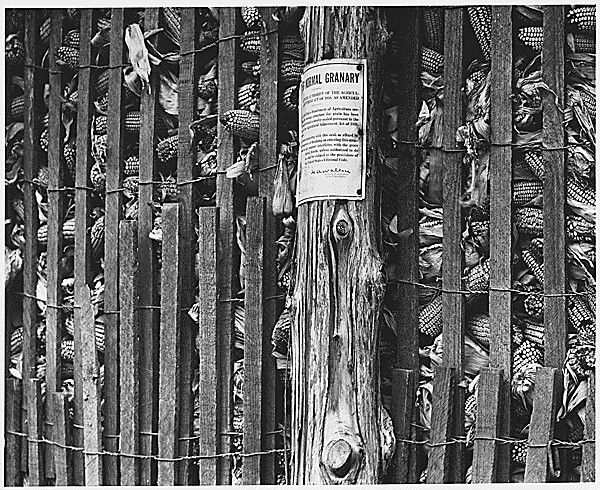
Document
Surplus Commodities Program
ca. 1936
This primary source comes from the Collection FDR-PHOCO: Franklin D. Roosevelt Library Public Domain Photographs.
National Archives Identifier: 195889
Full Citation: Surplus Commodities Program; ca. 1936; Collection FDR-PHOCO: Franklin D. Roosevelt Library Public Domain Photographs, . [Online Version, https://docsteach.org/documents/document/surplus-commodities-program, April 20, 2024]Surplus Commodities Program
Page 1
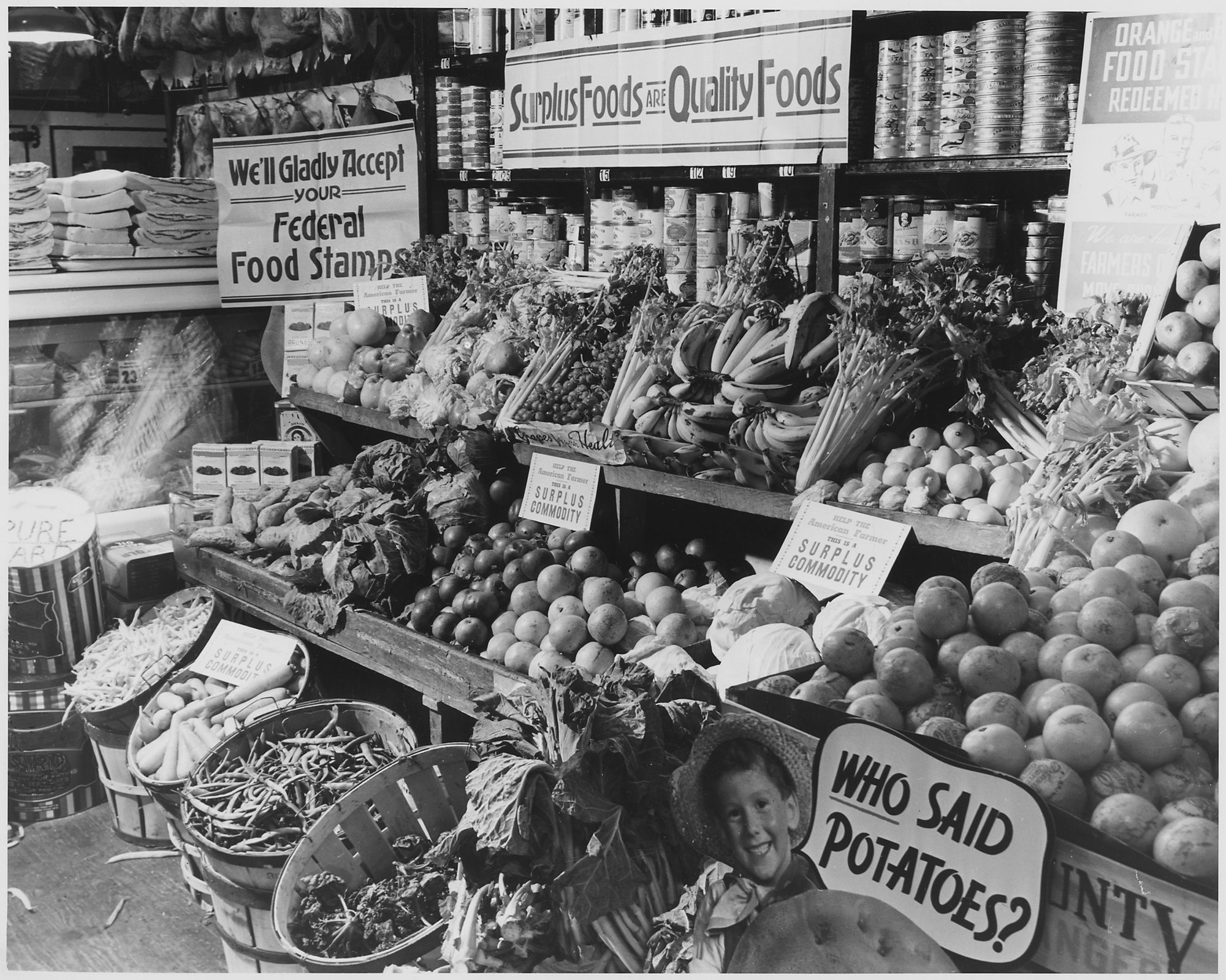
Document
'Your community can sponsor a school lunch program for its children' Make America Strong set. Poster number 10.
1941 - 1945
In 1935, Congress had passed legislation that enabled the secretary of agriculture to purchase surplus agricultural commodities, which were often used to provide school lunches for children who could not afford to pay. Federal funding of school lunches continued on a year-to-year basis during World War II. As the war drew to a close, many school boards hesitated to include the school lunch program because of the decrease in federal support through donated food. The House and Senate held hearings on the creation of a permanent school lunch program in 1944 and 1945, and President Harry S. Truman signed the National School Lunch Act into law on June 4, 1946. This is poster 10 from the Make America Strong set.
Text adapted from “Letter about the School Lunch Program” in the September 2009 National Council for the Social Studies (NCSS) publication Social Education.
Text adapted from “Letter about the School Lunch Program” in the September 2009 National Council for the Social Studies (NCSS) publication Social Education.
This primary source comes from the Records of the Office of Government Reports.
National Archives Identifier: 514939
Full Citation: Poster 44-PA-1313; 'Your community can sponsor a school lunch program for its children' Make America Strong set. Poster number 10.; 1941 - 1945; World War II Posters, 1942 - 1945; Records of the Office of Government Reports, ; National Archives at College Park, College Park, MD. [Online Version, https://docsteach.org/documents/document/your-community-can-sponsor-a-school-lunch-program-for-its-children, April 20, 2024]'Your community can sponsor a school lunch program for its children' Make America Strong set. Poster number 10.
Page 1
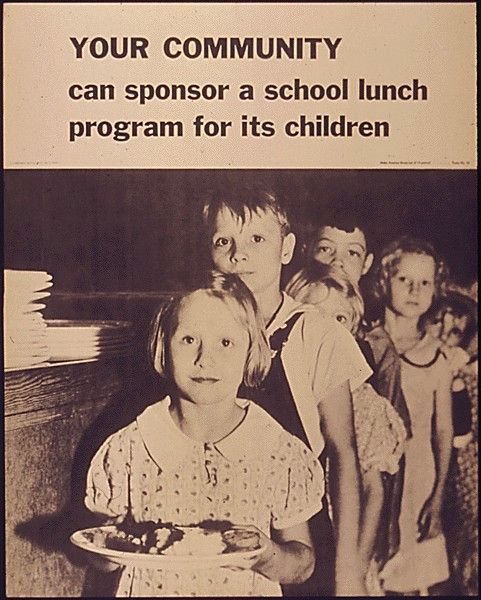
Document
'Every child Needs a Good School Lunch'
ca. 1941 - 1945
In its early years, school lunch was a child welfare program. Later it became a matter of national security. Malnourished children did not grow up to be good soldiers. In 1943 the War Food Administration took over — and dramatically expanded — the federal school lunch program.
This primary source comes from the Records of the Office of Government Reports.
National Archives Identifier: 514223
Full Citation: 'Every child Needs a Good School Lunch'; ca. 1941 - 1945; Records of the Office of Government Reports, . [Online Version, https://docsteach.org/documents/document/every-child-needs-a-good-school-lunch, April 20, 2024]'Every child Needs a Good School Lunch'
Page 1
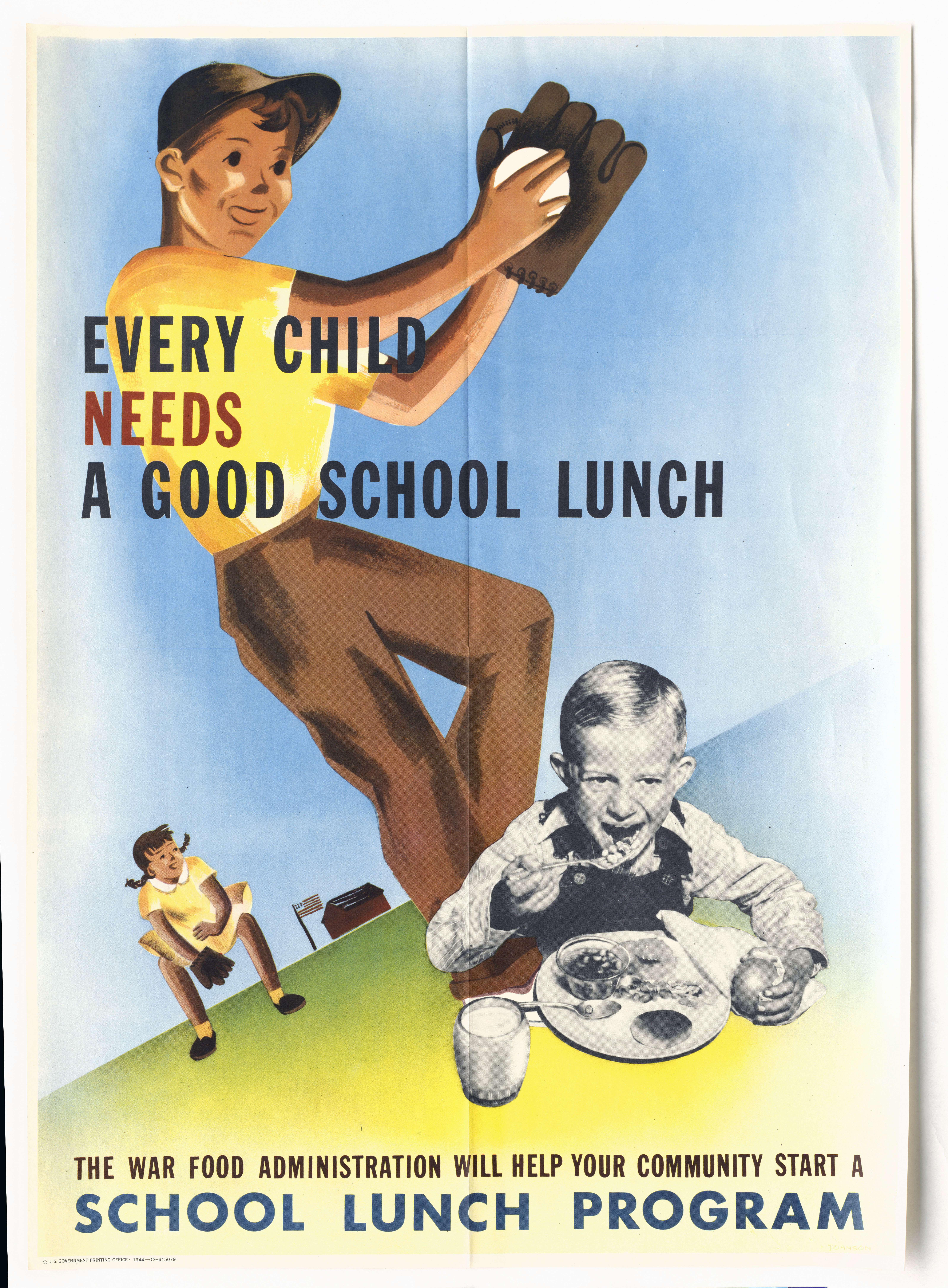
Document
Surplus Commodities: School Lunch Program
ca. 1936
Prior to the initiation of the Surplus Commodities program in 1936, “plow up” and “kill” methods were used to dispose of farm products. The decision to feed farm surplus to hungry school children was made after the public outcry over the Government’s slaughter of 6 million baby pigs.
Text adapted from “Letter about the School Lunch Program” in the September 2009 National Council for the Social Studies (NCSS) publication Social Education.
Text adapted from “Letter about the School Lunch Program” in the September 2009 National Council for the Social Studies (NCSS) publication Social Education.
This primary source comes from the Collection FDR-PHOCO: Franklin D. Roosevelt Library Public Domain Photographs.
National Archives Identifier: 195892
Full Citation: Surplus Commodities: School Lunch Program; ca. 1936; Franklin D. Roosevelt Library Public Domain Photographs, 1882 - 1962; Collection FDR-PHOCO: Franklin D. Roosevelt Library Public Domain Photographs, ; Franklin D. Roosevelt Library, Hyde Park, NY. [Online Version, https://docsteach.org/documents/document/surplus-commodities-school-lunch-program, April 20, 2024]Surplus Commodities: School Lunch Program
Page 1

Document
Letter from Mrs. Morton Livingston to Senator Claude Pepper Regarding the School Lunch Program
2/7/1946
On February 7, 1946, in response to an urgent bulletin sent to all Florida school districts by the state's department of education, Mrs. [Janette] Morton Livingston wrote to Senator Claude Pepper. The December 1945 bulletin expressed concern that the federal government might cease to fund the nation's school lunch program. In her single-page letter, Livingston, president of the Parent Teacher Association of Fort Ogden, Florida, urged the senator to support the program. Her earnest plea was among many letters and telegrams that the senator's office received as Congress held hearings on H.R. 3370, The National School Lunch Act. In 1935, Congress had passed legislation that enabled the secretary of agriculture to purchase surplus agricultural commodities, which were often used to provide school lunches for children who could not afford to pay. Federal funding of school lunches continued on a year-to-year basis during World War II. As the war drew to a close, many school boards hesitated to include the school lunch program because of the decrease in federal support through donated food. The House and Senate held hearings on the creation of a permanent school lunch program in 1944 and 1945, and President Harry S. Truman signed the National School Lunch Act into law on June 4, 1946.
Text adapted from “Letter about the School Lunch Program” in the September 2009 National Council for the Social Studies (NCSS) publication Social Education.
Text adapted from “Letter about the School Lunch Program” in the September 2009 National Council for the Social Studies (NCSS) publication Social Education.
This primary source comes from the Records of the U.S. Senate.
National Archives Identifier: 5815516
Full Citation: Letter from Mrs. Morton Livingston to Senator Claude Pepper Regarding the School Lunch Program; 2/7/1946; (SEN 79A-E5, H.R. 3370); Papers Accompanying Specific Bills and Resolutions, 1901 - 1946; Records of the U.S. Senate, ; National Archives Building, Washington, DC. [Online Version, https://docsteach.org/documents/document/letter-from-mrs-morton-livingston-to-senator-claude-pepper-regarding-the-school-lunch-program, April 20, 2024]Letter from Mrs. Morton Livingston to Senator Claude Pepper Regarding the School Lunch Program
Page 1
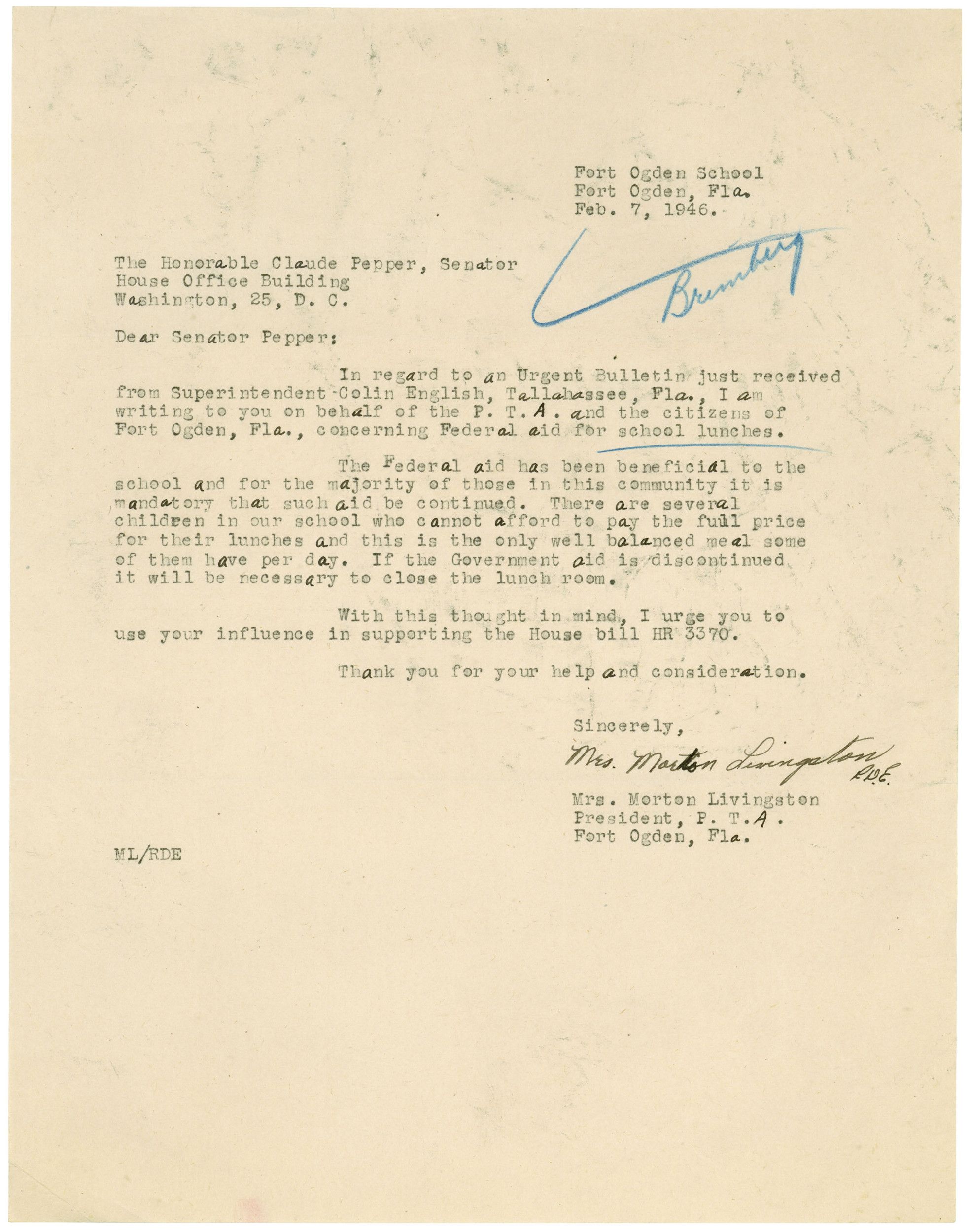
Document
School Lunch Recipes for 100
09/1946
Before the government began to allow commercial food companies to provide school lunches in the 1970s, meals were usually prepared on site. These recipes are from 1946, the year the National School Lunch Act made it a permanent, nationwide program.
This primary source comes from the Publications of the U.S. Government.
National Archives Identifier: 5711542
Full Citation: School Lunch Recipes for 100; 09/1946; Publications of the U.S. Government, . [Online Version, https://docsteach.org/documents/document/school-lunch-recipes-for-100, April 20, 2024]School Lunch Recipes for 100
Page 1
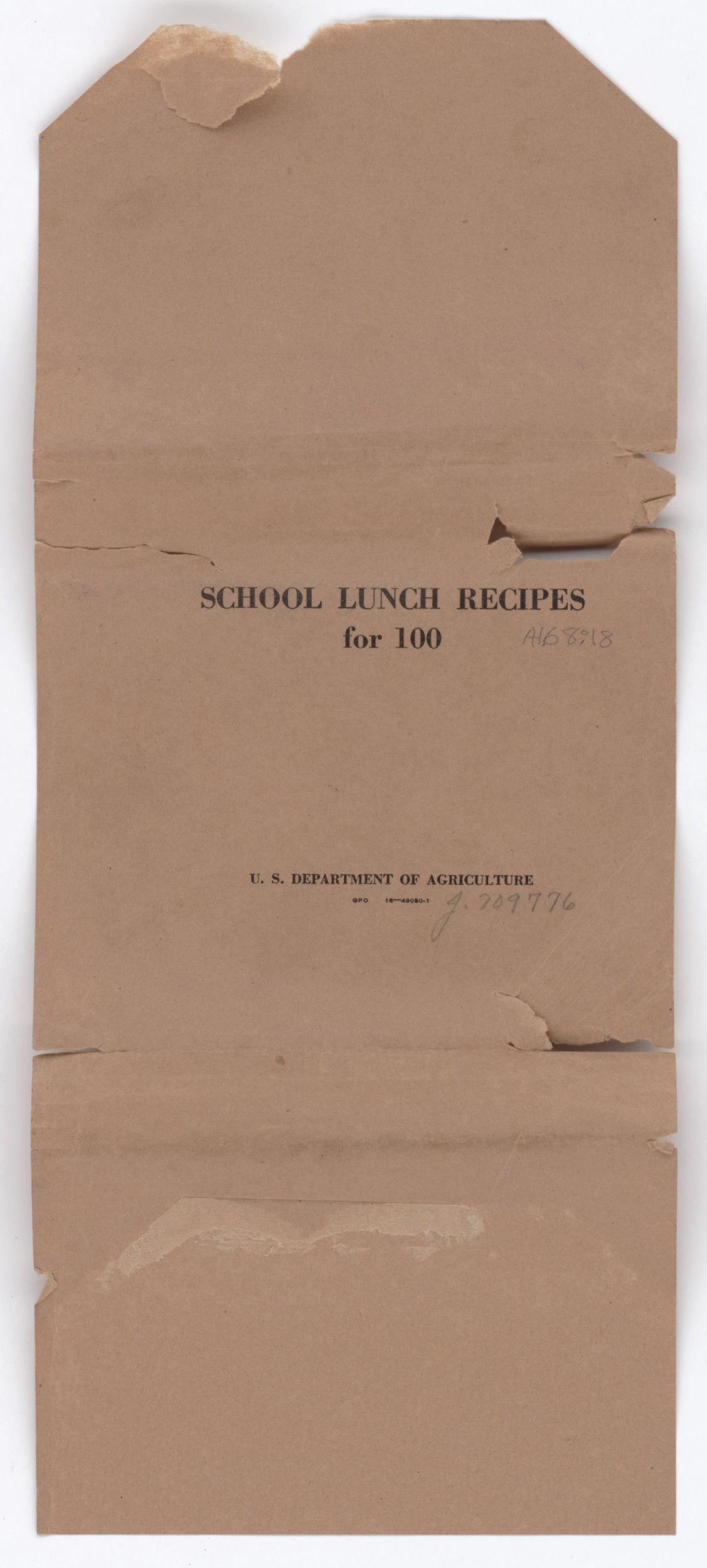
School Lunch Recipes for 100
Page 2
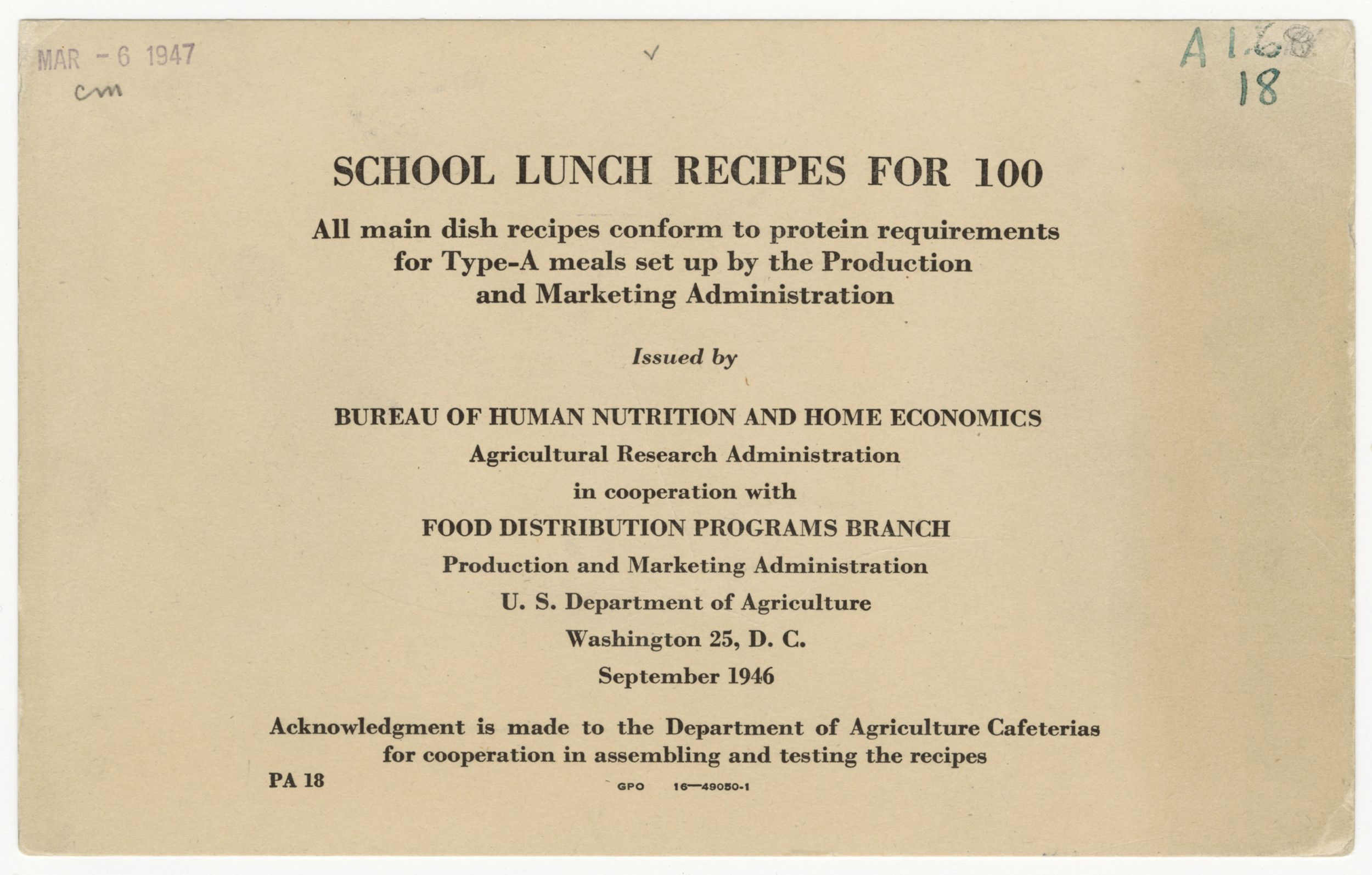
School Lunch Recipes for 100
Page 3

School Lunch Recipes for 100
Page 4
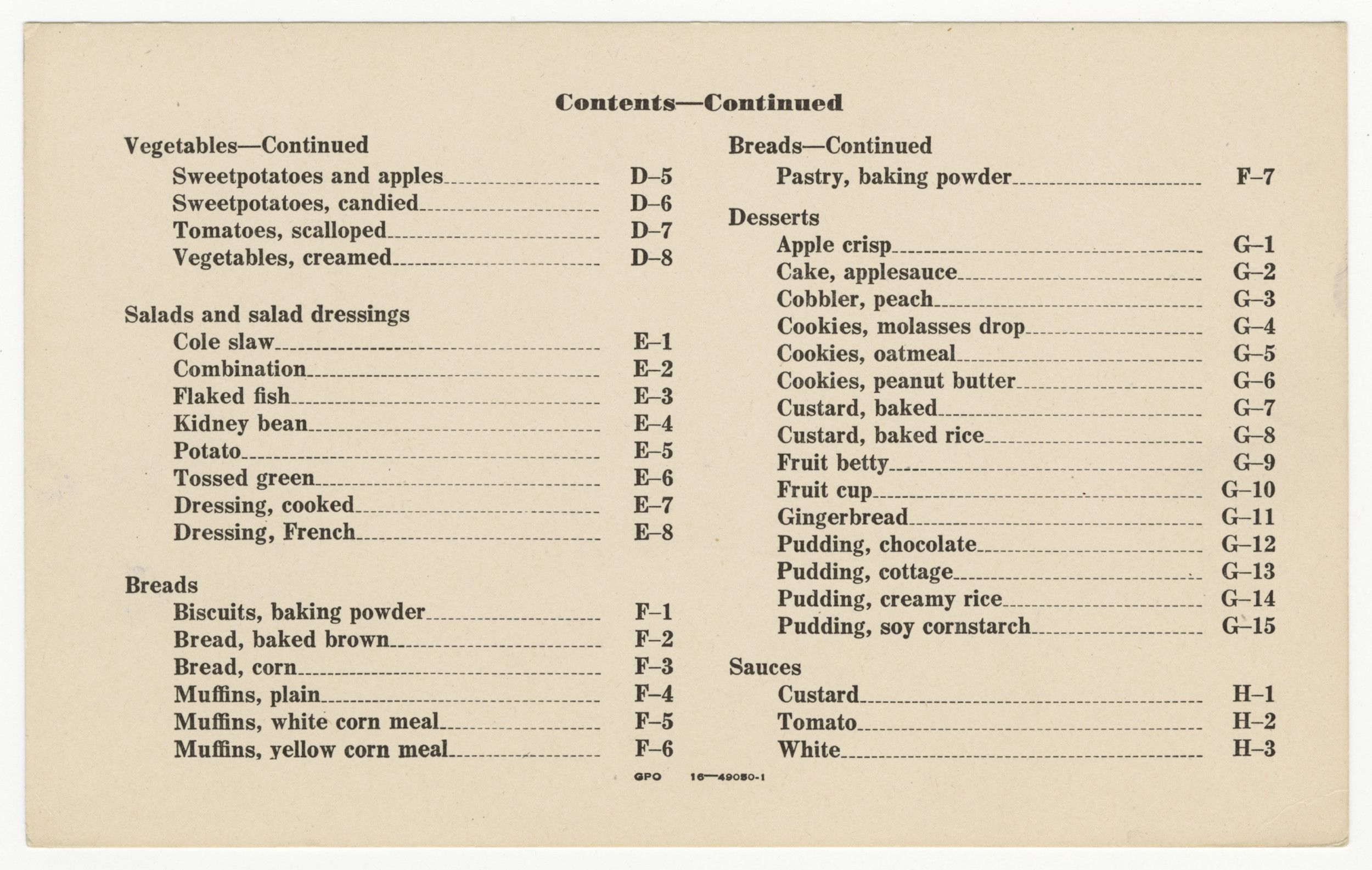
Document
Senate Democrats Dine on School Lunch
09/24/1981
In 1981, the USDA attempted to save a potential $1 billion by reclassifying ketchup and relish as vegetables. In protest, Senate Democrats staged luncheons made to the proposed new standards. The bad press and public outcry prevented the policy’s implementation.
This primary source comes from the Roddey E. Mims Collection.
National Archives Identifier: 5723121
Full Citation: Senate Democrats Dine on School Lunch; 09/24/1981; Roddey E. Mims Collection, . [Online Version, https://docsteach.org/documents/document/senate-democrats-dine-on-school-lunch, April 20, 2024]Senate Democrats Dine on School Lunch
Page 1
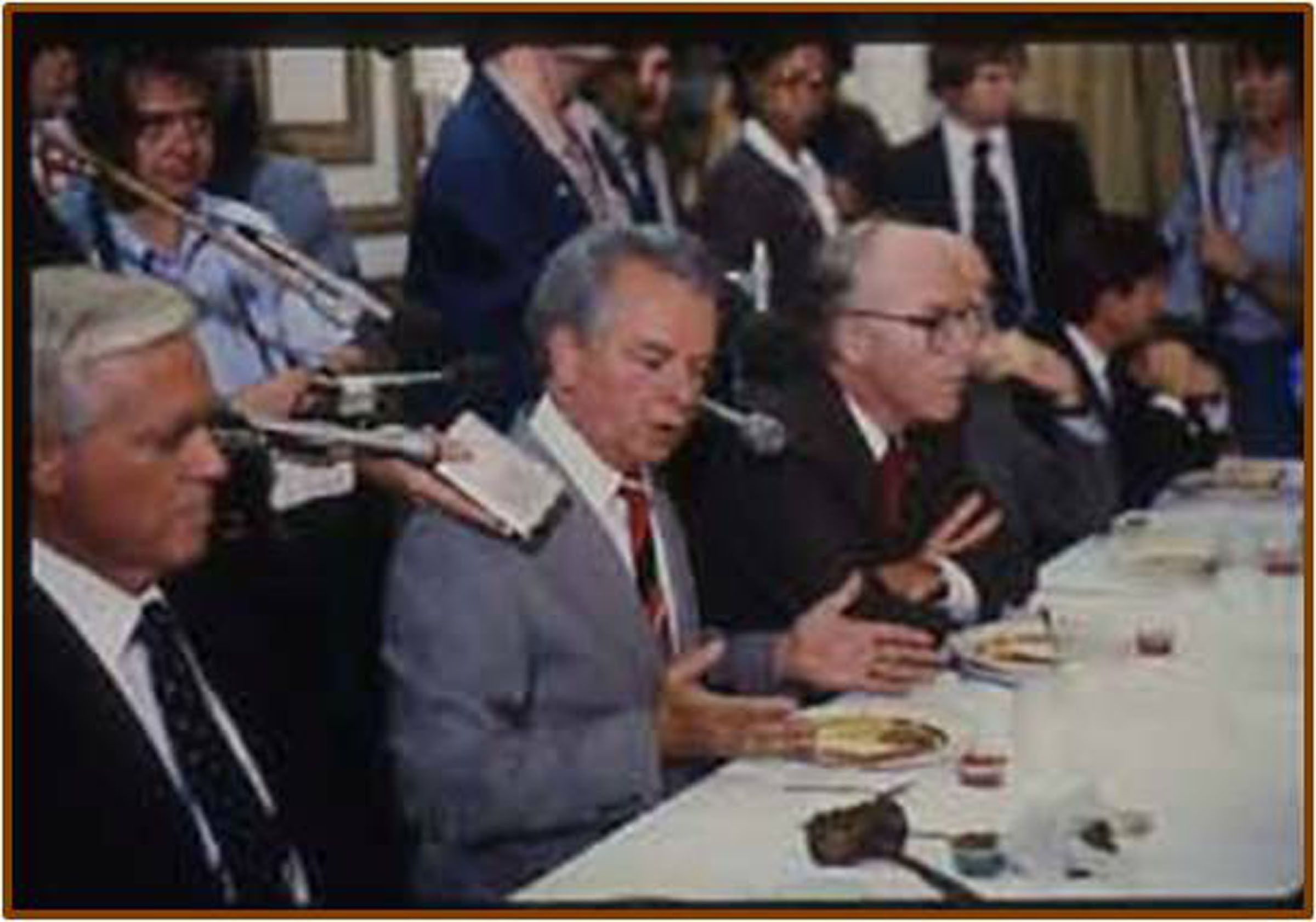
Document
Quantity Recipes for School Food Service
This image comes from a set of photographs of school food service used in slide presentations related to "Educational Programs on Nutrition, Food Production, and Natural Resources" by the Office of the Secretary of Agriculture.
This primary source comes from the Records of the Office of the Secretary of Agriculture.
National Archives Identifier: 5711560
Full Citation: Photograph 16-SP-FNS-5; Quantity Recipes for School Food Service; Photographic Presentations Relating to Educational Programs on Nutrition, Food Production, and Natural Resources, 1965 - 1987; Records of the Office of the Secretary of Agriculture, ; National Archives at College Park, College Park, MD. [Online Version, https://docsteach.org/documents/document/school-lunch, April 20, 2024]Quantity Recipes for School Food Service
Page 1

